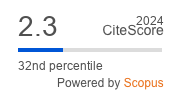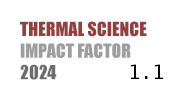ABSTRACT
Heat pumps meet the needs of the residential sector through the following three purposes: domestic water heating, space heating and cooling. This paper presents experimental research into the energy performance of an air-to-water heat pump in real summer changeover regimes, given that these are periods that significantly affect the reduction of efficiency. The transition regimes between the two regimes of operation with the most pronounced changes were especially considered. These were the transition regimes characteristic of operation in the summer period, namely: the transition from the space cooling regime to the domestic water reheating regime, and vice versa. In the observed period, the focus has been on 60 readings, with a resolution of 1 minute. In that period two changes in the operating mode were made, from the stationary space cooling regime (when the heat pump prepared water for the underfloor cooling at 17ºC) to the domestic water reheating mode (when the heat pump prepared hot water in the tank at 43ºC during the day), as well as switching to the previous, cooling mode. The research results show that in the observed period the heat pump worked in stationary regimes of space cooling and domestic water reheating, respectively, with average performance values of 3.52 and 4.75, and average exergetic efficiency of 6.93% and 33.38%.
KEYWORDS
PAPER SUBMITTED: 2025-01-17
PAPER REVISED: 2025-03-03
PAPER ACCEPTED: 2025-03-11
PUBLISHED ONLINE: 2025-04-05
- Salkuti, S. R. (2022). Emerging and Advanced Green Energy Technologies for Sustainable and Resilient Future Grid. Energies, 15(18), 6667. doi.org/10.3390/en15186667
- Bhowmik, C., Zindani, D., Chatterjee, P., Marinkovic, D., & Šliogerienė, J. (2024). Evaluation of green energy sources: an extended fuzzy-todim approach based on schweizer-sklar and power averaging operators. Facta Universitatis, Series: Mechanical Engineering, Online First, doi: 10.22190/FUME240711042B
- Romanov D., Leiss B., (2022), Geothermal energy at different depths for district heating and cooling of existing and future building stock, Renewable and Sustainable Energy Reviews, 167, art. no. 112727, doi: 10.1016/j.rser.2022.112727
- Mishra A.R., Rani P., Cavallaro F., Alrasheedi A.F., (2023), Assessment of sustainable wastewater treatment technologies using interval-valued intuitionistic fuzzy distance measure-based MAICRA method, Facta Universitatis, Series: Mechanical Engineering, 21(3), pp. 359 - 386, doi: 10.22190/FUME230901034M
- Balo F., Ivanović B., Stević Ž., Ulutas A., Marinković D., Demir H.B., (2024) Optimal Configuration of Spatial Planning for Energy-Efficient Buildings, Tehnicki Glasnik, 18, pp. 45-54, doi: 10.31803/tg-20241013235011
- www.iea.org/energy-system/buildings/heat-pumps
- Wang Y., Ye Z., Song Y., Yin X., Cao F., Energy, exergy, economic and environmental analysis of refrigerant charge in air source transcritical carbon dioxide heat pump water heater, Energy Conversion and Management, 223 (2020), 113209, pp. 1-13
- Szargut J., Component efficiencies of vapour-compression heat pump, Exergy, an International Journal 2 (2002), pp. 99-104
- Shen B., Hu Y., Development and field demonstration of residential air source integrated heat pump using a threestage compressor, Energy and Buildings, 328 (2025), 115202, pp. 1-13
- Yumrutas R., Kunduz M., Kanoglu M., Exergy analysis of vapor compression refrigeration systems, Exergy, an International Journal 2 (2002), pp. 266-272
- Bilgen E., Takahashi., Exergy analysis and experimental study of heat pump systems, Exergy, an International Journal 2 (2002), pp. 259-265
- Morosuk T., Nikulshin R., Morosuk L., Entropy-cucle method for analysis of refrigeration machine and heat pump cycles, Thermal Science, 10 (2006), 1, pp. 111-124
- Ahamed U.J., Saidur R., Masjuki H.H., A review on exergy analysis of vapor compression refrigeration system, Renewable and Sustainable Energy Reviews, 15 (2011), pp. 1593-1600
- Byme P., Ghoubali R., Exergy analysis of heat pumps for simultaneous heating and cooling, Applied Thermal Engineering, 149 (2019), pp. 414-424
- Kropp M., Lammle M., Herkel S., Henning H.M.,Schafer A.V., Enhancing heat pump performance for domestic hot water preparation: A comparative analysis in existing multi-family houses, 328 (2025), 115155, pp. 1-15
- www.scienceeurope.org/media/0vxhcyhu/se_exergy_brochure.pdf
- Bejan A., Tsatsaronis G., Moran M., Thermal design and optimization, John Wiley & Sons, Inc., New York, 1996
- Moran M., Shapiro H., Fundamentals of engineering thermodynamics, John Wiley & Sons Ltd., West Sussex, 2006
- Mergenthaler P., Schinkel A.P., Tsatsaronis G., Application of exergoeconomic, exergoenvironmental, and advanced exergy analysis to Carbon Black production, Energy, 137 (2017), pp. 898-907
- www.daikin.rs/sr_rs/products/ERLQ-CV3.table.html
- www.coolprop.org/index.html
- Ristić B., Metrology, Flow-technical measurements (in Serbian), Prosveta, Niš, 1981

